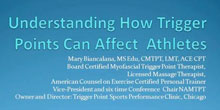Understanding How Trigger Points Can Impact Athletes - Part 1 Lower Body

Speaker: Mary Biancalana, MS, CMTPT, LMT
Mary is currently the owner and director of therapy for Trigger Point Sports Performance in Chicago, Illinois. She has treated and been endorsed by members of the Chicago Bears Football Team. She has traveled all over the country teaching the Trigger Point Therapy Protocol to licensed health care professionals including Licensed Massage Therapists, Athletic Trainers, PT’s , OT’s MD’s, DC’s, DO’s, NP’s, and Nurses.
Join us for a free 1 hour webinar sponsored by Custom Craftworks, a brand of Pivotal Health Solutions. While geared for Physical Therapists, Athletic Trainers, Personal Trainers and Massage Therapists, anyone can use this information to better understand how myofascial dysfunction can impact athletes, exercisers and everyone. Muscles that harbor Myofascial Trigger Points usually show a reduction in strength, power, and even coordination. If these muscles are not worked on, the dysfunction can continue and cause shifts in gait, posture, impaired athletic performance and ultimately can cause pain.
Myofascial Trigger Points are taut bands in muscle, that when pressed on refer pain to an often distant and predictable area. Dr Robert Gerwin reported that as many as 90% of the people entering the medical system with pain, have trigger points as the cause, yet they go undetected because so many health care providers are inadequately trained in their treatment. (Gerwin, RD 1995, Fishbain, DA 1986)
This workshop is especially important for those who work with athletes from all levels including professionals as well as the weekend warriors. This workshop will show the athlete, exerciser and the professionals who work with them how to self compress the muscles in the upper body to alleviate myofascial trigger point dysfunction. Range of motion restriction will be assessed for shoulder flexion, extension, abduction, adduction, circumduction and over all dynamic integrated function. The Travell and Simons model for identifying the most probable painful areas will be reviewed, as this will allow the practitioner to most accurately assess and teach the client self-compression techniques to allow return to full strength and performance.
Key perpetuating factors will be discussed. Trigger points cannot be fully eliminated unless the practitioner discovers what postures (during sleep, work, driving, exercise, and training) are out of neutral and can be causing the muscles to be dysfunctional. Structural assessment is also important, and will be discussed.
